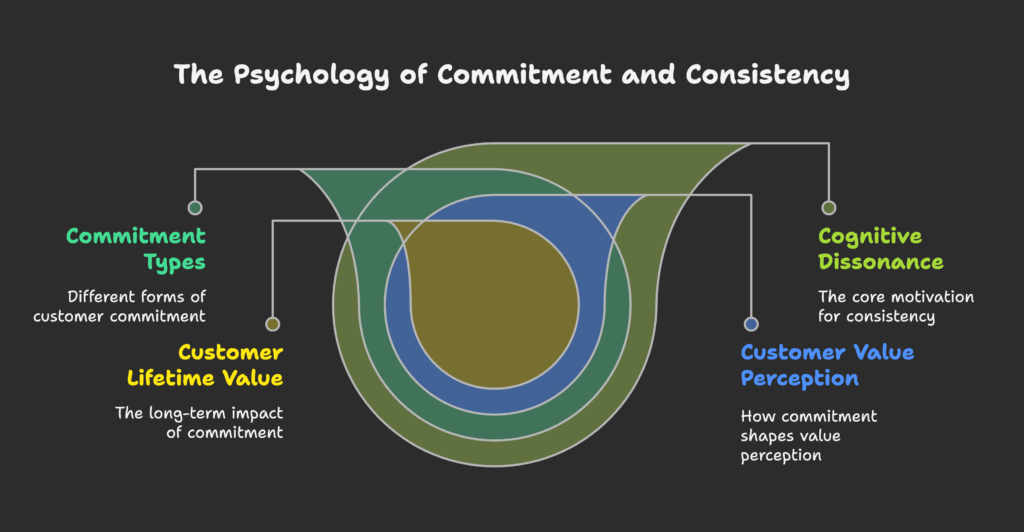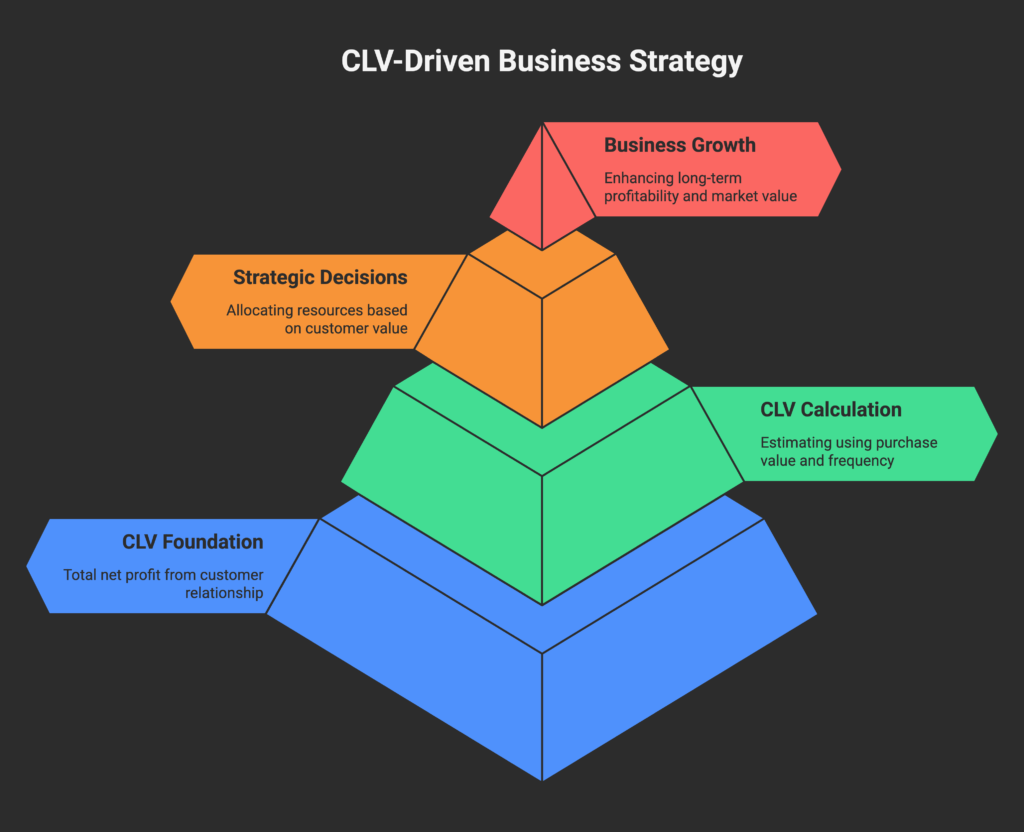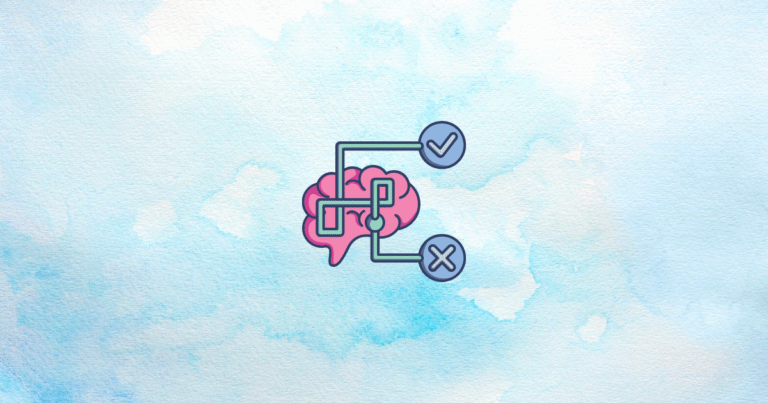Have you ever wondered why some customers keep coming back, almost as if they’re magnetically drawn to a brand? Or how certain companies manage to create a sense of loyalty that grows stronger year after year? In this article, you’ll uncover the psychological secrets behind commitment and consistency—and discover how they can supercharge your business results by increasing Customer Lifetime Value (CLV). By the time you finish reading, you’ll understand how to make small but powerful adjustments that lead customers to stay engaged for the long haul. Ready to dive in?
In this section, we’ll define both commitment and consistency as vital psychological triggers, and then we’ll introduce the concept of Customer Lifetime Value. You’ll see why these ideas are so important for profitability and get a glimpse of the exciting journey we’ll take throughout the rest of the article.
Defining the Key Concepts
According to Robert Cialdini’s well-known principles of persuasion, commitment and consistency play a central role in influencing human behavior. When a person commits to something—especially in writing or publicly—they’re more likely to remain consistent with that initial choice. This explains why simple actions, like checking a box or signing a form, can have a big influence on future decisions. Meanwhile, Customer Lifetime Value (CLV) measures the net profit a business can earn over the entire relationship with a customer. It’s a crucial metric because increasing retention by even a small margin can boost profits significantly.
We’ll see how these ideas link directly to business outcomes, but first, let’s establish the broader business rationale. Ready to see why consistency matters so much for the bottom line?
The Business Case for Integration
Consistency is the glue that keeps customers coming back. Numerous studies highlight that a small boost in retention—often cited between 5% and 10%—can lead to profit increases ranging from 25% to 95%. This multiplier effect happens because loyal customers tend to purchase more often, spend more, and spread positive word of mouth. Retaining existing customers is also more cost-effective than acquiring new ones, making the math very attractive for businesses of all sizes.
Now that you understand the direct link between consistency and profitability, let’s lay out what you can expect from the rest of this article. Up next, we’ll map out the roadmap of key topics and the objectives we aim to achieve.
Article Scope and Objectives
In the coming sections, we’ll explore how commitment and consistency influence customer behavior, and we’ll share proven strategies to boost lifetime value. We’ll also dig into real-world examples and case studies, so you can see how businesses put these principles into action. By the end of this article, you’ll have a clear framework, measurement methodologies, and practical insights to shape your own commitment-based strategies.
That wraps up our introduction. But we’re only getting started! Next, we’ll delve deeper into the psychology behind commitment and consistency. Are you ready to uncover the driving forces that make people stick to their decisions?
The Psychology of Commitment and Consistency
Welcome to the heart of the matter: why humans feel an urge to keep consistent with their stated commitments. In this section, we’ll discuss the main psychological foundations, explore different types of commitment in customer relationships, and uncover how these factors directly shape how people perceive value.

Psychological Foundations
Cialdini’s research explains that people strive to maintain internal harmony. Once they’ve made a choice (like signing up for a newsletter or trying out a service), they don’t want to feel the mental discomfort of contradicting that decision later. This phenomenon is closely tied to cognitive dissonance theory. Public or written commitments tend to be especially powerful, as they create a sense of accountability not just to oneself but also to others who have witnessed the commitment. The “foot-in-the-door” technique—where you start with a small request before building to a bigger one—capitalizes on this exact principle.
But commitment doesn’t look the same in every situation, so let’s explore the many forms it can take. Ready to see how they differ?
Types of Commitment in Customer Relationships
Customers can form either affective commitment (an emotional bond) or calculative commitment (driven by cost or convenience). Sometimes the commitment is completely voluntary, like joining a loyalty program, while in other cases it might be more “forced,” such as mandatory subscriptions to access certain services. Additionally, commitment can be initial (focused on first-time buyers) or ongoing (enabling repeat purchases). Social dynamics play a role too: group commitments can be extra powerful because people feel responsible to peers or fellow enthusiasts.
Once you know the form your customers’ commitment takes, you can tailor your strategies accordingly. Next, let’s uncover how these commitment types shape the way customers perceive your product or service value.
The Psychology of Customer Value Perception
When customers act consistently with their early commitments—like making a second purchase or posting a positive review—they start to view your products or services as more valuable. This reinforces a cycle: the more they stick to your brand, the more they justify their decision by believing the brand is worth it. Over time, consistent engagement creates an emotional investment that makes switching to a competitor feel less appealing. That emotional bond can also lower price sensitivity, as people often rationalize paying more for a brand they trust.
Now that we understand how commitment shapes perception, let’s see why Customer Lifetime Value is the ideal metric to track the long-term impact of these psychological drivers.
Understanding Customer Lifetime Value in Depth
Here, we’ll take a close look at what CLV really means, why it’s important, and how to calculate it. Then we’ll explore how CLV can guide strategic decisions across your organization. By the end of this section, you’ll see why commitment is more than just a marketing trick—it’s a powerful business principle for long-term growth.

Comprehensive Definition and Importance
Customer Lifetime Value is the total net profit a business earns from a single customer over the entire duration of the relationship. It’s a forward-looking metric that hints at future profitability. Companies with higher average CLV often enjoy higher market valuations because they have a loyal customer base that generates recurring revenue. Emphasizing CLV also shifts a company’s mindset from transactional to relationship-based, promoting better service, retention, and product quality.
But to make this metric actionable, you need a clear calculation method. Let’s see how that works next.
Key Components and Calculation Methods
A simple way to estimate CLV is:
- (Average Purchase Value) × (Purchase Frequency) × (Customer Lifespan)
More advanced calculations factor in discount rates, profit margins, and segmentation variables. Predictive CLV models use historical data and machine learning to forecast future spending. Historical methods rely on past patterns without predictive elements. Whichever approach you choose, understanding these components is vital for guiding decisions on budgeting, marketing campaigns, and product development.
Now, let’s see how CLV actually informs strategy, from allocating resources to deciding which products deserve the most attention.
CLV as a Strategic Decision-Making Tool
When you segment customers by their predicted or actual CLV, you can allocate resources more effectively. High-value segments may receive more personalized service or more robust loyalty perks. Marketing budgets can then be optimized to focus on campaigns that nurture the most profitable groups. Similarly, if a particular customer segment consistently brings high CLV, it might guide product development decisions toward features those customers prioritize.
Knowing the basics of CLV sets the stage for understanding how commitment directly affects it. Ready to see the big picture? Let’s move on to the strategic connection between commitment and lifetime value.
The Strategic Connection: How Commitment Drives Lifetime Value
In this section, we’ll build a framework that shows how initial commitments evolve into strong long-term relationships. We’ll also discuss specific mechanisms that directly boost CLV and explore the crucial role of consistent experiences.
Theoretical Framework
Think of it as the consistency–retention–value chain. Each small commitment deepens a customer’s sense of alignment with your brand. Over time, even modest actions, like upgrading a subscription or leaving a review, compound into major differences in lifetime value. Some research even shows that if 92% of people follow through once committed, compared to only around 50% without commitment, this can have a dramatic impact on your bottom line.
Next, we’ll look at practical commitment mechanisms you can integrate right away. Intrigued?
Commitment Mechanisms That Directly Impact CLV
Initial Purchase Commitments: The first purchase sets the tone. If you make that process smooth and rewarding, the likelihood of future purchases rises.
Subscription and Membership Models: Monthly or yearly memberships create built-in consistency. Customers pay repeatedly, reinforcing their own decision to stick with your service.
Loyalty Programs: These offer structured ways to earn points, achieve tiers, or gain exclusive perks, effectively turning occasional buyers into repeat customers.
Public Commitments (User-Generated Content and Reviews): Sharing positive experiences publicly encourages the customer to remain consistent with their words.
But commitment alone won’t work if the experience isn’t consistent. Let’s see why consistency of brand and service is so crucial.
The Role of Consistency in Customer Experience
When every touchpoint—from customer service calls to social media posts—aligns with the brand’s values, it strengthens trust. Consistency reduces the mental effort customers need to make decisions, because they know what to expect. If they encounter disjointed or unpredictable experiences, they may question their decision to commit. For this reason, brand consistency can be just as vital as quality in boosting CLV.
Now that we know how commitment and consistency boost CLV, let’s explore practical implementation strategies. Ready to transform theory into action?
Implementation Strategies: Building Commitment Mechanisms
Get ready to put these principles into practice. This section offers concrete tactics, from onboarding new customers to designing loyalty programs, optimizing communication, and weaving commitment into your product or service experience.
Initial Engagement and Onboarding
The journey starts with small, accessible steps. Invite customers to make tiny commitments, like creating a personal profile or joining an email list. Make sure your onboarding process is user-friendly and confirms the customer’s wise choice in selecting your brand. Offer meaningful “welcome” messages or quick tutorials that reinforce how much value they’ll gain.
Up next, we’ll see how loyalty programs can turn these early engagements into lasting, repeat behaviors.
Loyalty Program Design for Commitment
Loyalty programs work best when they feel rewarding, not just for immediate perks but for aspirational goals. Tiered structures—like bronze, silver, and gold levels—motivate people to stay consistent with their progress. Status and exclusivity can also enhance emotional bonds. The key is balance: offer enough instant gratification to keep customers engaged, but also extend long-term benefits that encourage them to remain loyal.
But loyalty programs aren’t the only way to keep people committed. Let’s see how strategic communication can amplify these efforts.
Communication and Content Strategies
Every message you send should reinforce your customer’s earlier choices. Emails that reference past purchases or highlight progress in a loyalty program help cement the notion of consistency. Social media posts that encourage sharing or reviewing create public commitments—once customers praise you in front of an audience, they’re more likely to stick around. Finally, testimonials from satisfied buyers also serve as a subtle nudge, suggesting, “If others love it, you probably made the right choice too.”
Effective communication is crucial, but your product or service experience needs to carry the commitment torch as well. Let’s discover how.
Product and Service Experience Design
Think of your product or service as a stage for continuous commitment-building. Reference past user interactions in the design, such as “Last time you visited, you explored X. Would you like to continue?” This acknowledges their history and makes them feel recognized. Service calls or chats can also reference previous purchases, demonstrating that you value and remember their loyalty. By involving customers in feedback loops—like voting on new features—you solidify their relationship with the brand.
Now that we have the strategies, how do we measure success and fine-tune our approach? Let’s find out.
Measuring the Impact of Commitment on CLV
In this section, we’ll explore which metrics matter most and how to conduct tests that reveal the real influence of commitment on your bottom line. We’ll also glance at advanced analytical methods to forecast future behaviors.
Key Metrics and KPIs
A few numbers can tell you a lot about whether your commitment strategies are working:
- Retention Rate: How many customers keep returning over a specific period?
- Purchase Frequency: Are customers buying more often?
- Average Order Value (AOV): Does it increase as commitment grows?
- Referral Behavior: Are committed customers recommending your brand to others?
- Engagement Metrics: Which channels show higher commitment levels?
These indicators serve as windows into your customers’ long-term loyalty. Next, let’s see how to test different approaches and keep refining.
Testing and Optimization Frameworks
A/B testing is an excellent way to see if a particular commitment mechanism is moving the needle. You might compare two onboarding processes or two loyalty program structures to see which leads to better retention or higher purchase frequency. Cohort analysis can track how different groups respond over time. By experimenting, learning, and iterating, you’ll continually improve the effectiveness of your commitment-building strategies.
For those looking to go even deeper, advanced analytics can push your strategy further. Let’s take a quick look.
Advanced Analytics Approaches
Predictive models can assess who is most likely to remain loyal based on past behaviors and demographic data. These insights inform segmentation, so you can tailor messages to high-commitment or at-risk groups. Attribution models can also help you pinpoint which touchpoints—like email campaigns or membership perks—are most responsible for driving commitments. Machine learning algorithms then refine these insights over time, enabling more precise interventions.
Of course, numbers tell only part of the story. Sometimes, real-world examples make everything clearer, so let’s check out some success stories next.
Case Studies and Success Stories
Now it’s time to see how various industries use commitment and consistency to grow CLV. We’ll explore retail and e-commerce, dive into service industry applications, and see how B2B firms also leverage these principles.
Retail and E-commerce Examples
Amazon Prime: Members pay an annual fee, which increases their sense of commitment. They also enjoy perks like fast shipping—making it likely they’ll keep shopping there.
Sephora’s Beauty Insider: This loyalty program offers points, exclusive gifts, and different status tiers. Shoppers feel motivated to maintain and grow their standing.
Warby Parker’s Home Try-On: Trying out glasses at home creates a light, fun commitment that often leads to future purchases.
Dollar Shave Club: Subscriptions eliminate the need to think about reordering, which naturally fosters consistency.
Let’s see how the service industry adapts similar methods to lock in long-term loyalty.
Service Industry Applications
Starbucks Rewards: By gamifying purchases and offering exclusive promotions, Starbucks makes each visit feel like progress toward a larger goal.
Banking and Finance: Banks deepen engagement through progressive commitments like premium checking accounts or bundled services, encouraging customers to keep everything under one roof.
Fitness Industry: Gyms use ongoing commitments—monthly memberships and class packages—to maintain engagement.
Professional Services: Firms may offer “knowledge commitments,” like free seminars or insider reports, that draw clients deeper into the relationship.
Next, we’ll see how B2B settings also benefit from these principles.
B2B Commitment Strategies
Enterprise Software Onboarding: Detailed implementation steps create gradual commitments, each reinforcing the idea that switching providers would be inconvenient.
Professional Networks: LinkedIn groups or specialized industry forums keep members engaged, driving them to return for new content and connections.
B2B Loyalty Programs: Though less common than B2C models, structured perks can still drive consistency in wholesale and enterprise relationships.
Training and Knowledge-Sharing: Offering specialized training content or certifications nurtures a deeper bond with your brand.
Of course, any approach can come with challenges, especially ethical ones. Let’s examine those next.
Potential Challenges and Ethical Considerations
Balancing profits with fairness can be delicate. In this section, we’ll look at how to keep customers on your side without crossing lines. We’ll also discuss how to handle fatigue and privacy concerns to maintain trust.
Balancing Commitment with Customer Freedom
Commitment tactics should help customers feel empowered, not manipulated. Being transparent about how your loyalty programs work and why you gather data can build trust rather than suspicion. By fostering genuine relationships and offering real value, you show that you respect your customers’ autonomy.
In the next subsection, we’ll tackle the very real issue of commitment overload—how to avoid it and deal with it if it happens.
Customer Irritation and Commitment Fatigue
Even the best-intentioned strategies can overwhelm customers if they’re bombarded by too many requests for sign-ups, upsells, or reviews. Look for signs of exhaustion—like declining engagement or unsubscribe rates—and then reduce your frequency or change your messaging. Provide clear options to adjust preferences or pause notifications, ensuring a healthier long-term relationship.
Finally, let’s consider how to remain ethical and secure when dealing with personal data.
Data Privacy and Personalization Concerns
Collecting data to tailor experiences can be powerful, but it must be done responsibly. Adhere to privacy regulations and always be transparent about data usage. When customers trust that you handle their information carefully, they’re more likely to stay consistent with your brand.
Now that we’ve addressed potential pitfalls, let’s look ahead to emerging trends that will shape commitment-based CLV strategies.
Future Trends in Commitment-Based CLV Strategies
As technology evolves and consumer expectations change, so do the ways we can build and maintain commitment. This section will discuss advancements, shifting attitudes, and deeper integration with other systems.
Technological Developments
Artificial intelligence can now personalize the commitment journey. Automated systems can identify the right moment to prompt a small “foot-in-the-door” action or recognize patterns that indicate readiness for a bigger commitment. Voice technology and chatbots can also collect micro-commitments in real time, further enhancing the customer experience.
Yet technology isn’t everything. Let’s see how cultural and generational changes might affect these strategies.
Evolving Consumer Expectations
Younger consumers, like Gen Z, value authenticity and transparency. They’re quick to spot insincere tactics. Privacy concerns are also on the rise, meaning companies have to be more respectful in how they gather and use data. That said, if done ethically, commitment-based techniques can still resonate strongly with younger audiences, especially when combined with genuine brand storytelling.
Finally, let’s look at how commitment fits into the larger business ecosystem.
Integration with Other Business Systems
Many companies are moving toward customer data platforms (CDPs) that unify information from multiple channels. This allows for a cohesive view of each customer’s commitment journey. Integrated systems can also sync with CRM tools, so your sales, marketing, and customer service teams align around a single source of truth. This cross-functional approach ensures consistent customer interactions, further solidifying commitment.
Ready to put these insights into action? Let’s move to a step-by-step guide.
Implementation Guide: Building Your Commitment-CLV Strategy
Here’s where we bring it all together. From auditing your current efforts to rolling out new initiatives, this guide will help you plan your next steps in a structured way.
Assessment and Planning Framework
Start by auditing your existing commitment mechanisms. Do you have a loyalty program? Subscriptions? Referral incentives? Then calculate your current CLV and segment customers by value. Identify where small improvements could yield the biggest gains. Finally, allocate resources according to these findings to ensure maximum efficiency.
Next, we’ll look at how to stage your rollout in phases to manage complexity.
Phased Implementation Roadmap
Phase 1: Quick Wins
Focus on the easiest ways to boost engagement, like optimizing your onboarding process or adding a single, well-designed loyalty perk.
Phase 2: Medium-Term Commitment Systems
Roll out subscription models or advanced loyalty tiers. Use data insights from Phase 1 to refine your approach.
Phase 3: Long-Term Cultural Shift
Embed commitment principles into your company culture, making them part of every department’s strategy. Continuously optimize based on feedback and evolving trends.
Of course, people bring it all to life. Let’s not forget the team aspect.
Team Structure and Responsibilities
Cross-functional collaboration is key. Marketing, product development, customer service, and data analytics teams should share a unified commitment roadmap. Offer training so each team understands how commitment strategies relate to their tasks. Consider performance metrics and incentives that align with building long-term customer relationships rather than chasing short-term gains.
We’re nearing the end of our deep dive, but let’s bring it all together in a final conclusion with the main takeaways and an action plan.
Conclusion
Congratulations on making it to the end of this comprehensive guide! You now have a full picture of how commitment and consistency can supercharge Customer Lifetime Value. So what should you remember most as you move forward?
Key Takeaways
- Consistency and CLV are strongly linked: Each small commitment can lead to significant gains over time.
- Ethical application matters: Show transparency and genuine care when using commitment tactics.
- Strategic metrics guide progress: Track retention, purchase frequency, and other KPIs to optimize your efforts.
- Cross-functional adoption is crucial: Ensure your entire organization supports a commitment-centered approach.
Building relationships isn’t just about immediate sales—it’s about nurturing bonds that pay off for years to come.
Getting Started
If you’re new to these concepts, start by making small changes, like improving the onboarding experience or introducing a simple loyalty program. Monitor your metrics, learn from the data, and expand your commitment strategies as you gain confidence. Above all, keep your customers’ best interests at heart, and you’ll see results that benefit everyone.
Quick Tip for Shopify Store Owners: Don’t forget that you can boost your sales even further with tools like the Growth Suite app. It can help you manage and implement many of the strategies discussed here—making it easier to grow a loyal, high-value customer base.
Keep experimenting, keep refining, and you’ll soon be on your way to creating deeper, more profitable relationships with your customers. Happy scaling!




